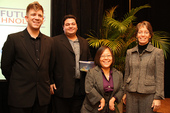Highlight
Hands Free Interaction with Computers
Achievement/Results
Researchers at Wright State University are seeking ways to improve the accessibility to information technologies for people who are unable to use standard input devices such as the keyboard and the mouse. This work involves collaborations with local partner, Brain Actuated Technologies, Inc. and with Danish researchers at IT Copenhagen. This research is one component of a strategic commitment that Wright State University has made to universal access to education.
Leveraging the advantages of a campus designed to accommodate students with mobility impairments, the university has placed specific emphasis on improving the opportunities for students with severe physical disabilities to pursue careers in STEM fields (Science, Technology, Engineering, and Mathematics). The work is supported by two major grants from the National Science Foundation. One of the NSF awards comes from the NSF’s IGERT Program (Integrative Graduate Educational and Research Traineeship). This award supports a multidisciplinary graduate research program in Learning with Disability (LwD). The LwD program is a collaboration between the College of Science and Mathematics and the College of Engineering that involves Ph.D. programs in Biomedical Sciences, Computer Science, Engineering, and Human Factors & Industrial/Organizational Psychology.
The bulk of the funding for the IGERT program goes to stipends and research support to graduate students whose dissertation research is directed to enhancing learning opportunities for people with disabilities. The second award, from NSF’s Research in Disabilities Education (RDE) program supports the Ohio STEM Ability Alliance (OSAA). The OSAA is a collaboration between Wright State, Ohio State, Columbus State, and Sinclair Universities to increase the numbers of students with disabilities who succeed in STEM careers. OSAA is specifically designed to increase the participation and success of students with disabilities in STEM fields of study. The program includes comprehensive advising, learning communities, mentoring, and internship programs. The OSAA program is additionally supported by the State of Ohio in the form of Choose Ohio First Scholarships for Ohio students with disabilities who choose STEM undergraduate majors at OSAA institutions.
The Brainfingers Accessibility System
The Brainfingers Accessibility System is being developed by local entrepreneur Andrew Junker. Research on this system began in collaboration with the Air Force as a potential way to enhance the interface between pilots and their aircraft. More recently it has attracted the interest of computer gamers who are always seeking a competitive edge. The research collaboration between WSU and Brain Actuated Technologies is being supported by a recent grant from the National Center for Technology Innovation (NCTI). WSU graduate students, Jennifer Border, Jeh Cooper, and Jim Leonard recently presented their research at the NCTI National Conference in Washington, D.C., where they were given the Brightest Idea Award as one of the most innovative programs currently being supported by NCTI.
The Brainfingers system senses electrical potentials that result from both muscle (e.g., EMG, EOG) and neural (central nervous system) activity. The associated software is able to filter the signals into distinct channels (or brainfingers) associated with the different sources. Activity of the brainfingers can then be mapped to computer commands (e.g., discrete key presses or mouse clicks or proportional cursor movements). The research program at WSU is assessing the viability of this system for improving accessibility to information technology for individuals who are unable to use standard input devices (e.g., keyboard or mouse).
Eye-Gaze Interaction
Researchers at Wright State have also been collaborating with researchers at IT Copenhagen to develop affordable systems for eye-gaze interactions with computers. These systems are designed to allow people to perform the point and click operations needed to interact with computers (e.g., to surf the web) using their eyes. Again, target populations are those who, due to motor limitations, are unable to use standard devices (e.g., keyboards or mouse). Systems designed at IT Copenhagen use inexpensive, off-the-shelf cameras as the primary source of information for tracking eye-movements. The positive aspect of this is the affordability of these devices, the drawback is the resolution of the eye-tracking. The challenge is to compensate for low camera resolution with clever design of the interactions. The development work at IT Copenhagen is directed by Professor John Paulin Hansen and this work is supported though a European Research Consortium (COGAIN – COmmunication by GAze INteraction).
Address Goals
The primary focus of the Learning with Disabilities IGERT is to improve accessibility to education and learning through the effective use of information technologies. This highlight describes specific projects directed toward hands free interactions with computers. This is essential for people who, due to motor impairments, are unable to use standard devices for interacting with computers (e.g., keyboard and mouse).
This work is explicitly designed to attract students with disabilities to STEM fields of research by emphasizing the practical benefits of this research for their own access to education and careers.
The problem-centered focus of this research spans the fields of cognitive psychology, engineering, and neuroscience. This approach reflects cutting edge theory about the embodied or situated nature of cognition. In this context, ‘computation’ is seen not as something that happens “in the head” but as a function that is distributed over the brain, technology, and problem ecology. Thus, this research challenges conventional dualistic ontologies and forces students to appreciated interactions between mind and matter – to address issues of what matters!








